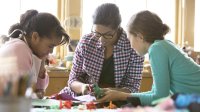Getting Started With Self-Organized Learning Environments
Tips for creating a more student-centered and collaborative classroom.
Sugata Mitra, promoter of the self-organized learning environment (SOLE) concept, challenges teachers to become the ultimate facilitators of learning and to reimagine our classrooms as spaces for discovery where students are given the tools to succeed as we stand back and “watch the learning happen.”
This past year, I began teaching a new project-based elective for middle school students called 3D Storytelling, which combines humanities and STEAM objectives. Students use the design process to create their own pop-up books. Before they begin, they must build a foundation of knowledge of both storytelling and paper engineering. Many students have seen a pop-up book before, but few, if any, have asked themselves, “How can I make this?” To build the foundation of knowledge, my supervisor encouraged me to adopt SOLE as my main approach. I was intrigued yet nervous. I wanted to empower students to take more responsibility over their own learning, yet so much about the approach went against my teaching instincts. What would it look like if I were to hand over the majority of my 55-minute class period to my students?
To my surprise, my journey with SOLE has exceeded my expectations and greatly impacted my practices. SOLE is an effective method for fostering student-centered learning for middle school students—and can work well for all grade levels.
Use SOLE to Introduce New Concepts
SOLE is not meant to be the only method of teaching in a classroom. Consider it a tool for introducing and generating interest in a new topic, as well as broadening your students’ understanding of a familiar topic. SOLE practitioners recommend that you use it about once a week for the first three weeks after you introduce it.
To prepare your SOLE session, formulate a “big question” related to your topic that will lead your students to an intended outcome. Crafting the big question is the most challenging piece of the SOLE puzzle; it’s important that it be a question that cannot be answered through an internet search. For example:
- Weak Big Question: What is the design process?
- Strong Big Question: How can I use the design process to create ____?
Post your big question on the board and spend no more than two minutes explaining it. Tell students they have the majority of the period to work in small groups to come up with an answer, and that they will share out their answers at the end of class. It’s helpful to make a timer available so students can manage their time appropriately.
Allow Group Flexibility
In SOLE, students can choose their research groups. And groups are fluid, which means students can switch groups throughout the period, moving to a group that is more aligned with their interests.
Initially, the idea of group fluidity did not come naturally for me or for the students. I noticed that some of them formed certain groups simply because they already knew one another. But because groups are formulated on common interests, it’s important that students feel comfortable working with those they don’t know as well. It’s useful to set up frequent “getting to know you” activities.
As students became more familiar with each other, their curiosity began to trump their desire to be with friends. I watched students move from one group to another because they either wanted to remove themselves from a potentially distracting situation or were more interested in another group’s direction of research.
Make Sure Resources Are Available to Students
I provide links to several websites and tutorials I’ve found that relate to the big questions I ask my students to explore. This not only saves time but provides students with a starting point for their research.
Through formative assessment, I was surprised to learn that my students don’t all prefer technology when it comes to research and self-teaching. For that reason, I always provide an array of options for their research. My classroom research library contains books, textbooks, articles, and model texts.
Self-Evaluation Exit Tickets
My main objective for starting with SOLE was to foster an environment for student self-management and self-reliance. At the beginning of the marking period, students themselves came up with “Habits of a Self-Managing Student.” I wrote these habits on an anchor chart and displayed them in the classroom as a reminder.
At the end of each SOLE session, students grade their own self-managing behaviors on exit tickets—and they are surprisingly accurate. Based on their self-evaluations, students set personal goals for themselves for our next SOLE session.
Resist the Urge to Problem-Solve
Students will be shocked and a bit frustrated the first time you answer a question with “I don’t know.” Although it’s hard, try to resist sharing your knowledge and ideas. Students can turn to one another for help. You can also ask them where they think they could find their answer and guide them through the research process.
Adopting SOLE may seem overwhelming, but with persistence and patience you will quickly begin to see the benefits in both your students and your teaching practice.
